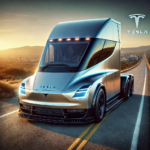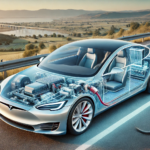Introduction
The concept of flying cars has long been a staple of science fiction, tantalizing us with the promise of a future where the skies teem with personal vehicles. In recent years, however, this dream has edged closer to reality. Companies such as Joby Aviation, Airbus, and Terrafugia are pioneering the development of flying cars, blending aviation and automotive technology into a single, futuristic solution. But what does the future hold for this groundbreaking innovation? Over the next five years, flying cars are poised to redefine transportation, urban planning, and environmental policies in ways we are only beginning to understand.

The Current State of Flying Car Technology
Progress and Challenges
Flying cars, also known as Vertical Take-Off and Landing (VTOL) vehicles, are no longer mere prototypes. Companies have successfully tested various models capable of short-distance flights, hovering capabilities, and even autonomous operation. For instance, Joby Aviation has conducted multiple successful test flights, aiming for a commercial launch as early as 2025. Meanwhile, Hyundai’s Urban Air Mobility (UAM) project is focusing on developing flying taxis to ease urban congestion.
Despite these advancements, significant challenges remain. Technical barriers such as battery capacity, noise reduction, and air traffic management systems must be addressed before flying cars can become a viable solution. Regulatory hurdles also loom large, with governments and aviation authorities needing to establish comprehensive guidelines for airspace usage, safety, and licensing.
Potential Impacts of Flying Cars in the Next Five Years
1. Transforming Urban Transportation
Flying cars promise to alleviate some of the most pressing issues in urban transportation, including traffic congestion and long commute times. By utilizing vertical take-off and landing capabilities, these vehicles can bypass ground traffic entirely, drastically reducing travel time for daily commuters.
For instance, a typical 90-minute drive in a congested city could be cut down to just 15 minutes by air. This could make flying cars an attractive option for professionals in densely populated cities such as New York, Tokyo, or Mumbai. Additionally, the emergence of ride-sharing services using flying taxis, like those proposed by Uber Elevate, could democratize access to this technology.
2. Revolutionizing Logistics and Emergency Services
Flying cars are not just about personal mobility; they have the potential to revolutionize logistics and emergency services. Imagine a world where medical supplies or organs for transplant can be delivered directly to hospitals in minutes, bypassing traffic delays. Similarly, flying cars equipped for search and rescue missions could reach disaster zones quickly, saving lives in critical situations.
E-commerce giants like Amazon are already experimenting with drone deliveries, and flying cars could further enhance these capabilities by transporting larger payloads over longer distances, even to remote areas.
3. Impact on Urban Infrastructure
The widespread adoption of flying cars will necessitate significant changes in urban infrastructure. Traditional parking lots may give way to “vertiports” — specialized hubs for take-offs, landings, and charging. Buildings might be designed with rooftop docking stations, integrating flying cars into the fabric of city life.
However, these changes will require substantial investment and planning. Cities will need to reimagine their layouts, balancing ground-based transportation with aerial mobility. The challenge will lie in creating a seamless integration that minimizes disruption while maximizing efficiency.
4. Environmental Considerations
Flying cars have the potential to reduce carbon emissions, especially if they are powered by electric engines. By offering a more direct route to destinations, they can decrease fuel consumption and greenhouse gas emissions. However, the environmental impact will depend heavily on the energy sources used. If powered by renewable energy, flying cars could contribute to a greener planet. On the other hand, reliance on fossil fuels or inefficient batteries could negate these benefits.
Challenges Ahead
1. Cost and Accessibility
Initially, flying cars are likely to be expensive, putting them out of reach for the average consumer. High manufacturing costs, coupled with the expense of maintenance and operation, may restrict their adoption to affluent individuals or corporations. However, as technology matures and economies of scale come into play, prices are expected to drop, making flying cars more accessible over time.
2. Regulatory and Safety Issues
Flying cars will require a completely new regulatory framework. Governments and aviation authorities will need to address airspace management, pilot licensing, and safety standards. Ensuring that flying cars operate without endangering traditional aircraft or ground-based infrastructure will be a complex task.
Moreover, safety concerns such as mid-air collisions, system malfunctions, and emergency landings will need to be rigorously addressed through robust engineering and fail-safe mechanisms.
3. Social Acceptance
Public perception could also be a barrier. Many people may be apprehensive about the safety of flying cars or skeptical of their practicality. Building trust through transparent testing and consistent performance will be essential for widespread acceptance.

The Role of Governments and Private Sector
Governments will play a pivotal role in shaping the future of flying cars. By funding research, updating aviation laws, and incentivizing the use of sustainable technologies, they can accelerate the adoption of this transformative mode of transport. Private sector companies, on the other hand, will need to focus on innovation, cost reduction, and consumer education to make flying cars a mainstream reality.
The Road Ahead: A Timeline
2025:
- Launch of commercial flying taxi services in select cities.
- Increased investment in infrastructure such as vertiports.
2026-2027:
- Expansion of flying car networks to additional urban areas.
- Development of hybrid models capable of longer distances.
2028-2030:
- Gradual reduction in costs due to advancements in technology.
- Greater adoption in logistics, emergency services, and personal transportation.
Conclusion
Flying cars are not just a futuristic fantasy; they represent a tangible step forward in how we navigate our world. While challenges remain, the potential benefits—from reduced congestion and faster commutes to greener and more efficient transportation—make them an exciting prospect for the next five years. By embracing innovation and addressing the obstacles ahead, we may soon witness the skies filling with vehicles that redefine mobility and transform our cities.
The dream of flying cars is closer than ever. Are you ready for takeoff?







